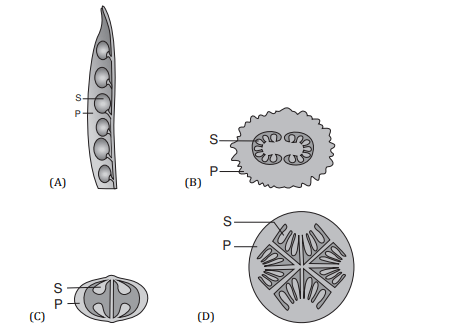1.After fertilization which part of flower generally withers and falls off?
a) Sepals
b) Petals
c) Stamens
d) All of these
Explanation: All of these
2. Select the false statement.
a) Ovule develops into seed
b) Ovary develops into fruit
c) Zygote develops into embryo
d) Placenta develops into pericarp
Explanation: "Placenta develops into pericarp". This is false statement.
3.A, B, C and D shows which type of placentation respectively?
a) A: Marginal, B: Free central, C: Perietal, D: Axile
b) A: Perietal, B: Marginal, C: Axile, D: Free central
c) A: Axile, B: Free central, C: Marginal, D: Perietal
d) A: Axile, B: Perietal, C: Free central, D: Marginal
Explanation: A: Marginal, B: Free central, C: Perietal, D: Axile
4. Gametes in haploid organisms are produced by
a) Amitosis
b) Mitosis
c) Meiosis
d) Cleavage
Explanation: Mitosis
5. Embryonal protection and care are better in
a) Oviparity
b) Parthenogenesis
c) Viviparity
d) Polyembryony
Explanation: Viviparity
6. After fertilization in angiosperms, ovules develop into
a) Pericarp
b) Fruit
c) Seed
d) Embryo
Explanation: After fertilization in angiosperms, ovules develop into seed.
7. ‘A’ in the diagram shows:

a) Testis of a male cockroach
b) Ovary of a female cockroach
c) Testis of an earthworm
d) Ovary of an earthworm
Explanation: Testis of a male cockroach
8. The progenitor of the next generation inside the mature seed is known as
a) Micropyle
b) Pericarp
c) Embryo
d) Zygote
Explanation: The progenitor of the next generation inside the mature seed is known as embryo.
9. Identify the ploidy of the following parts of flowering plants.
Ovary, Anther, Egg, Pollen, Male gamete and Zygote
a) 2n, 2n, n, n, n, 2n
b) 2n, 3n, n, n, 2n, 2n
c) 2n, n, n, n, n, 2n
d) 2n, 2n, n, 2n, n, 2n
Explanation: 2n, 2n, n, n, n, 2n
10.Select the correct statement from the following.
(A) In flowering plants, the zygote is formed inside the ovule.
(B) In reptiles and birds, the fertilized eggs covered by hard calcareous shell (Cleidoic) are
laid in a safe place in environment.
(C) In organisms belonging to fungi and algae, the zygote develops a thick wall that is
vulnerable to dessication and damage.
(D) During embryogenesis, zygote undergoes cell division and cell differentiation.
a) A and C only
b) A, B and C only
c) C and D only
d) A, B and D only
Explanation: A, B and D only
